Kostroma Region of Russian Federation The Town of
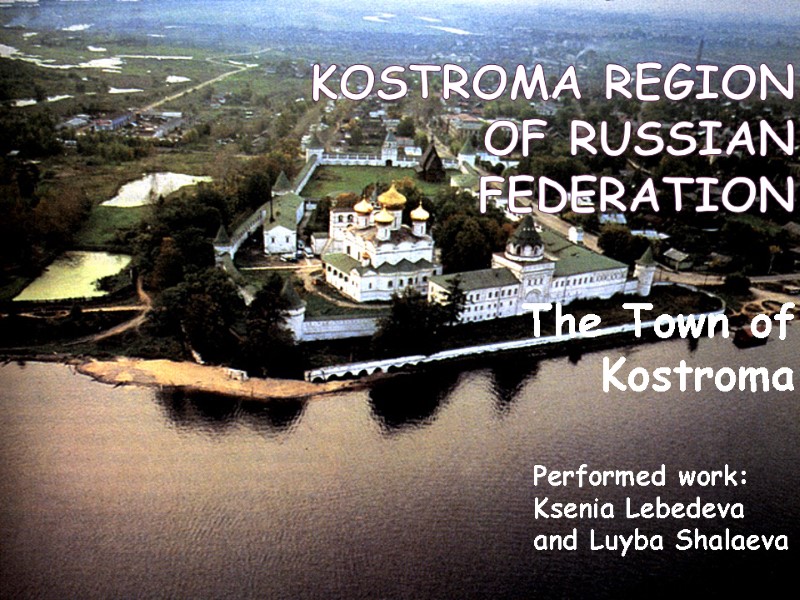
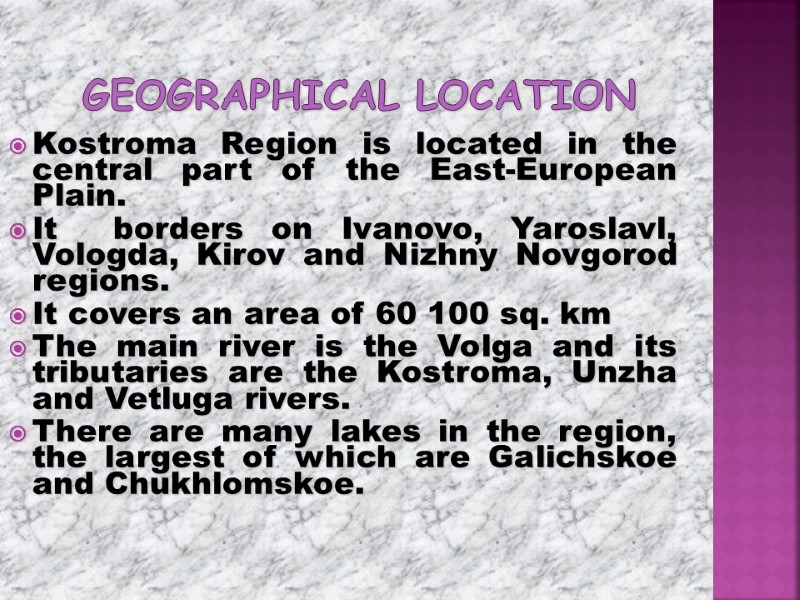
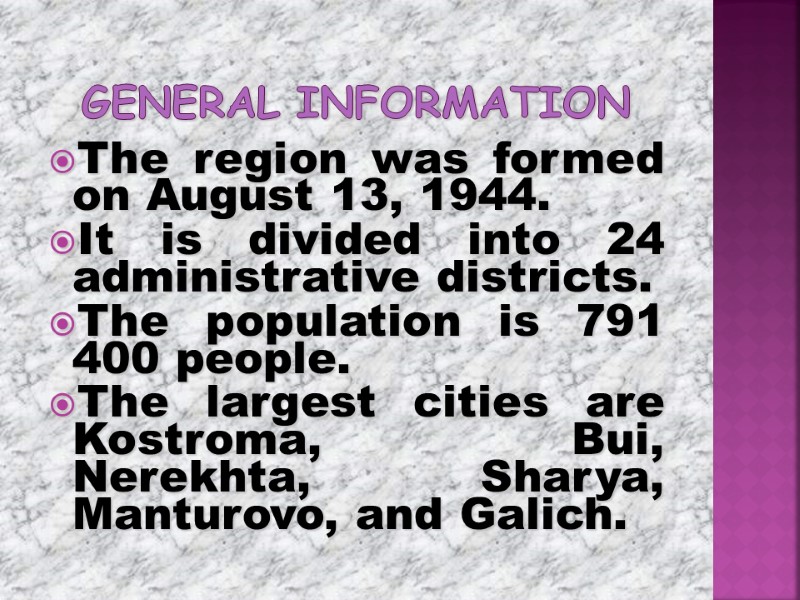
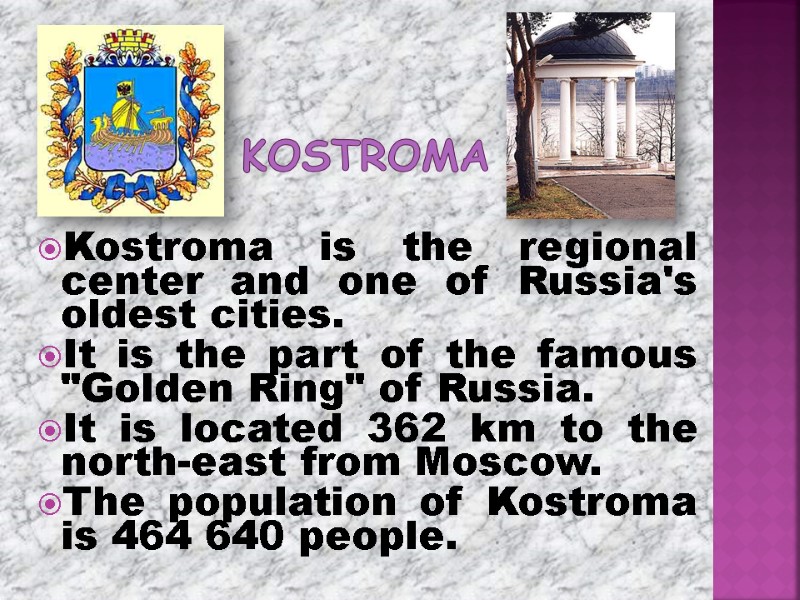
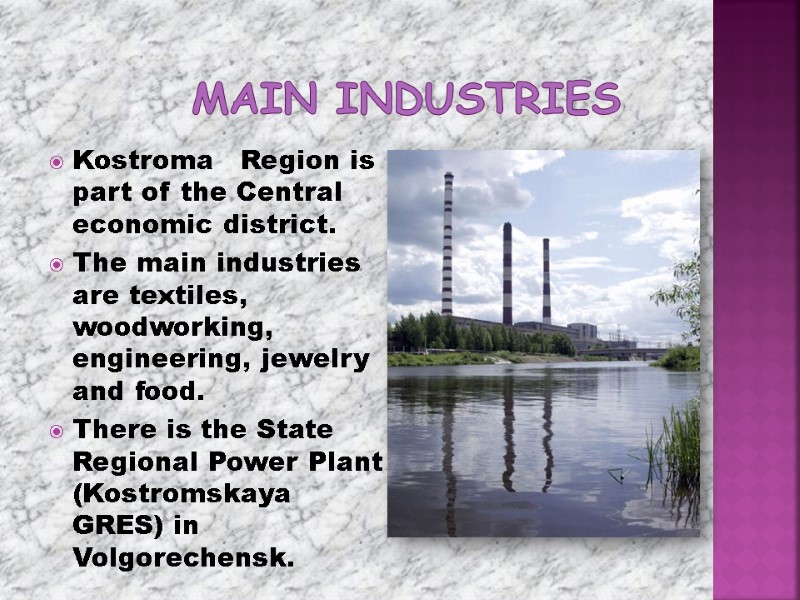
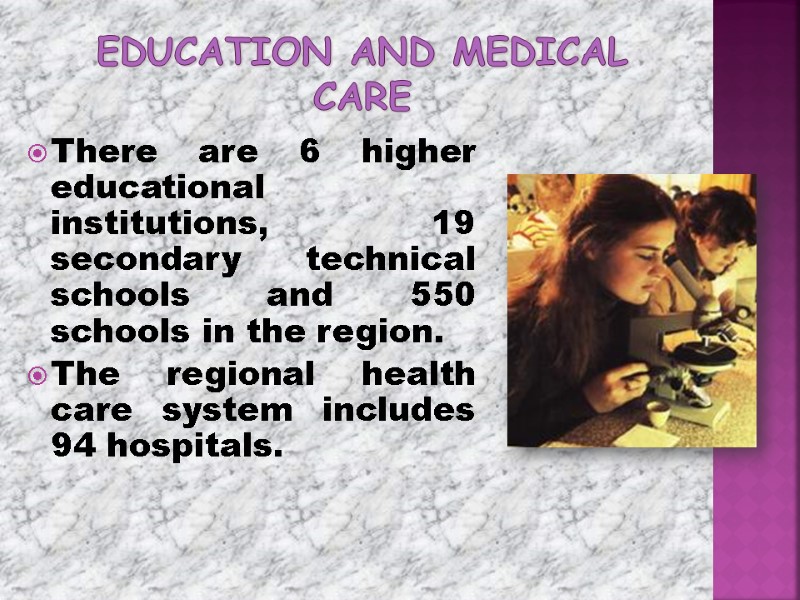
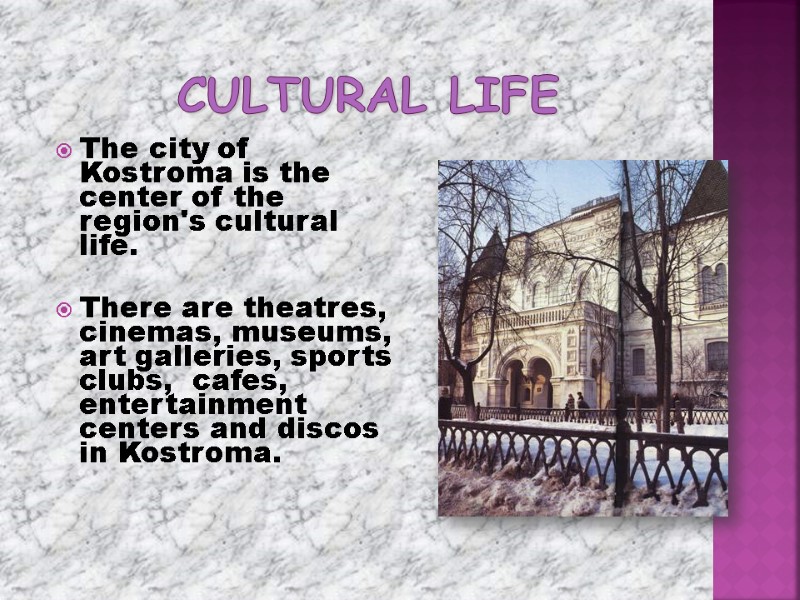
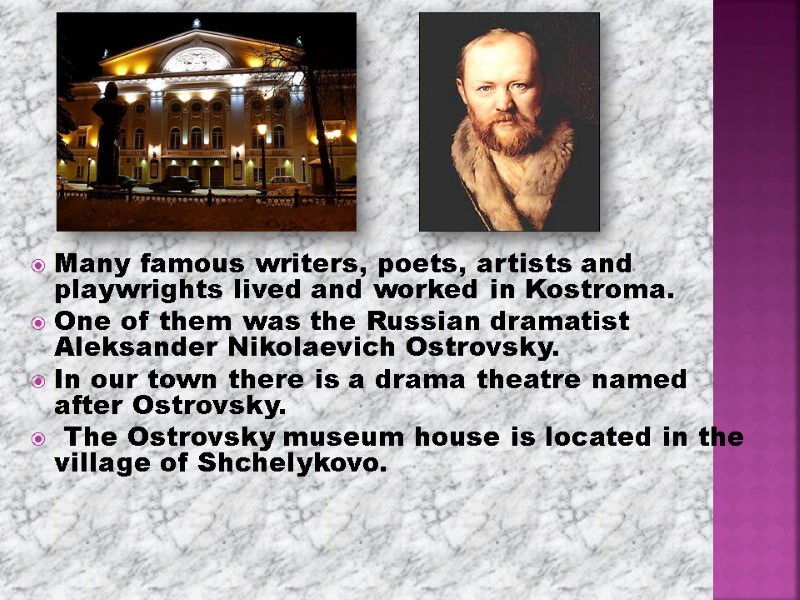
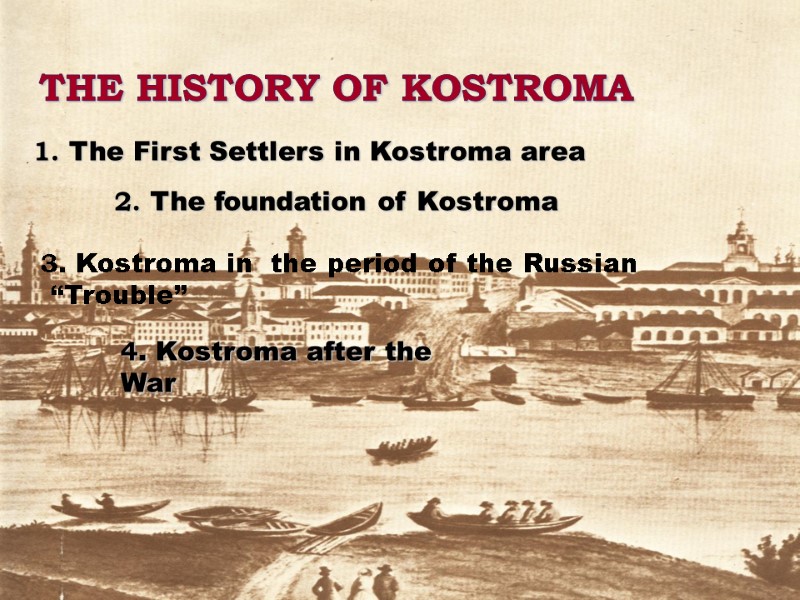
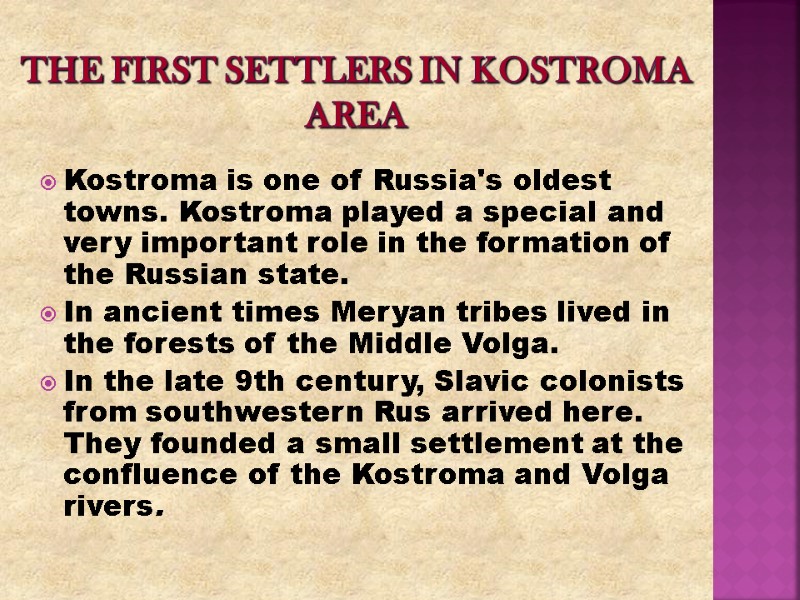
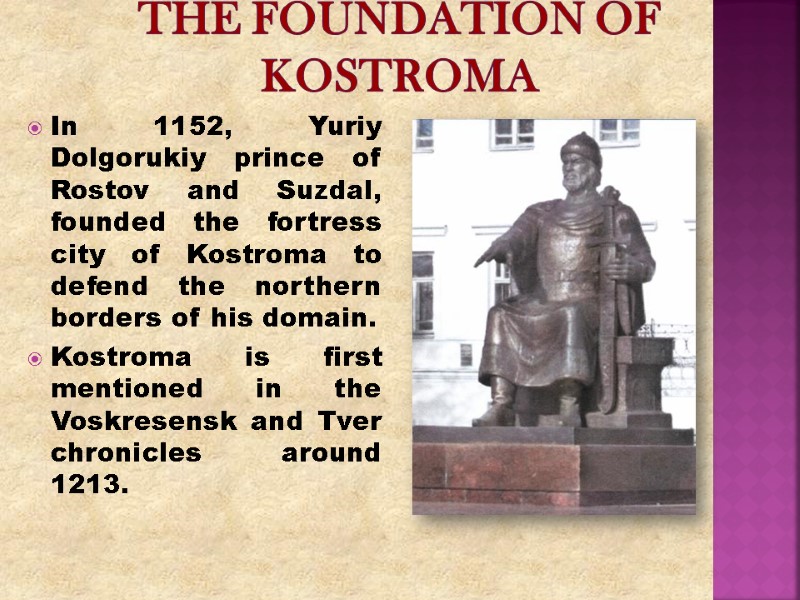
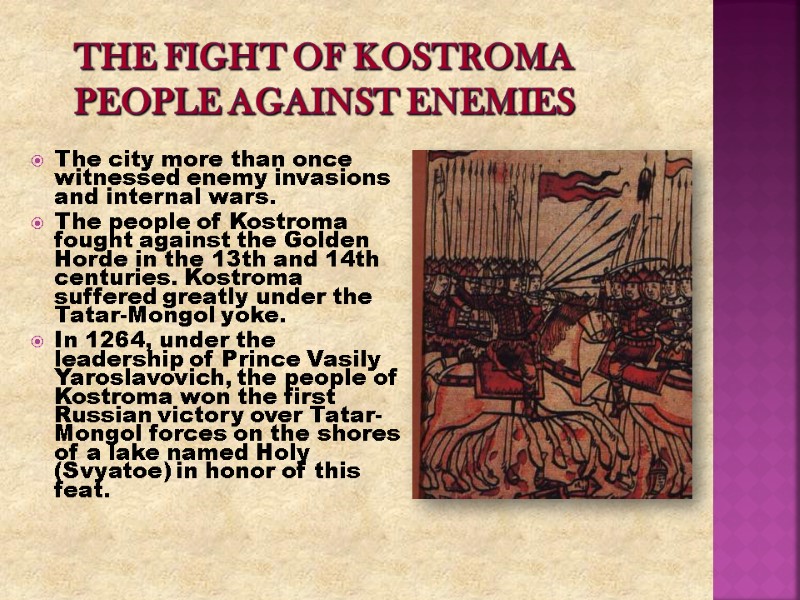
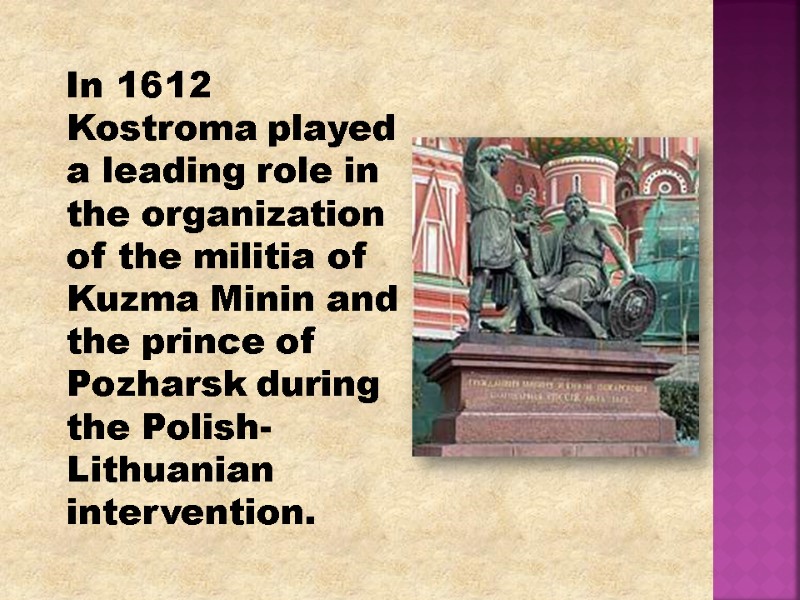
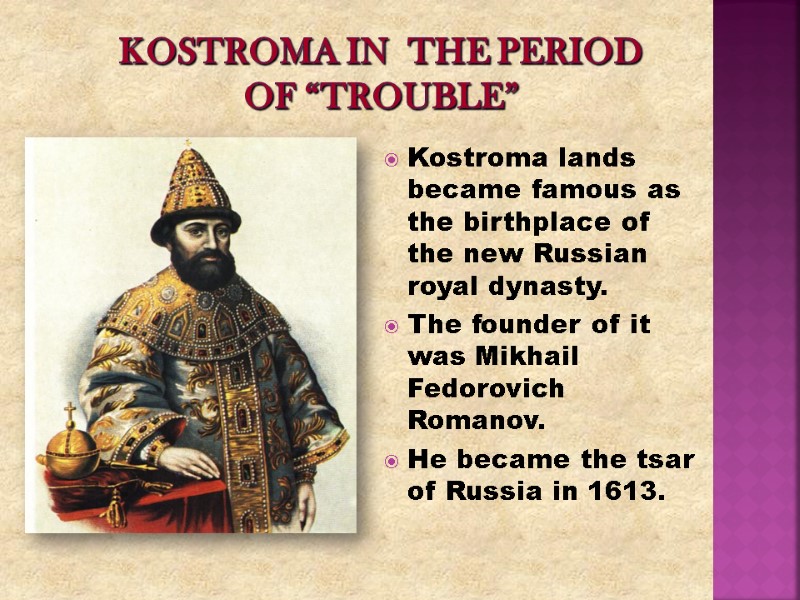
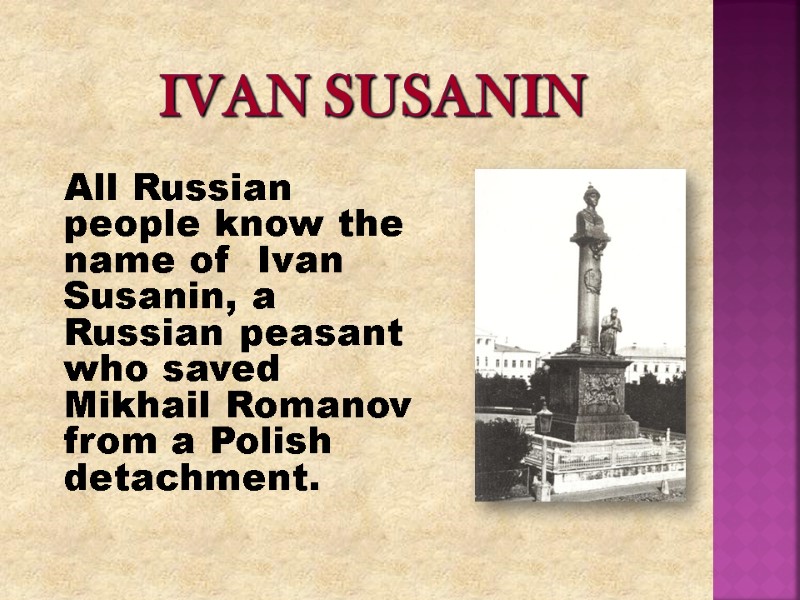
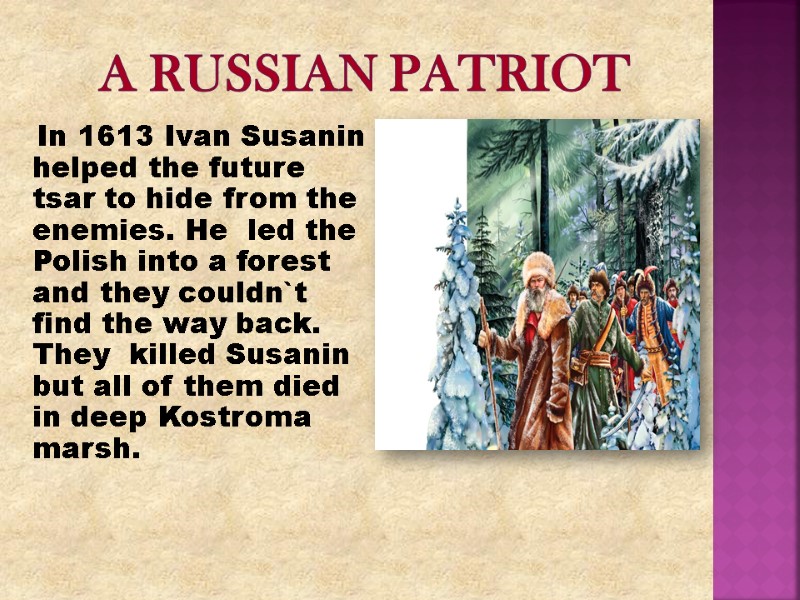
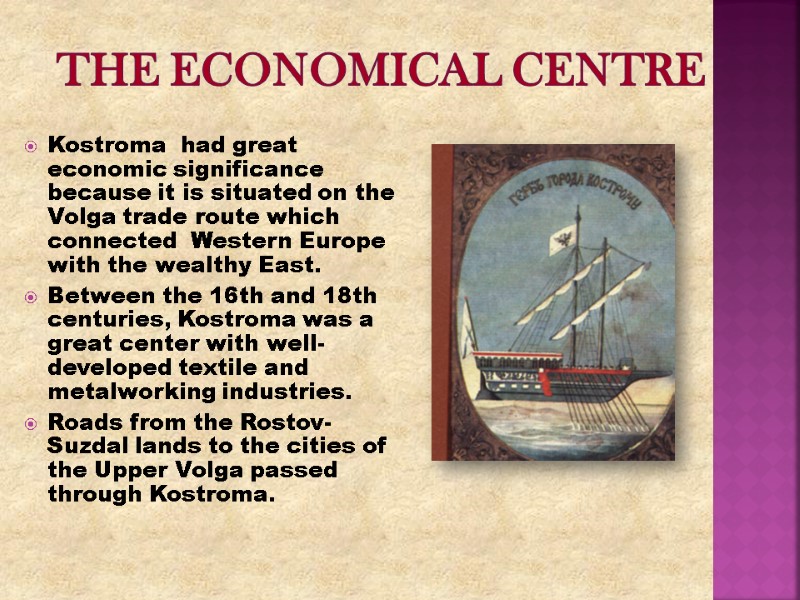
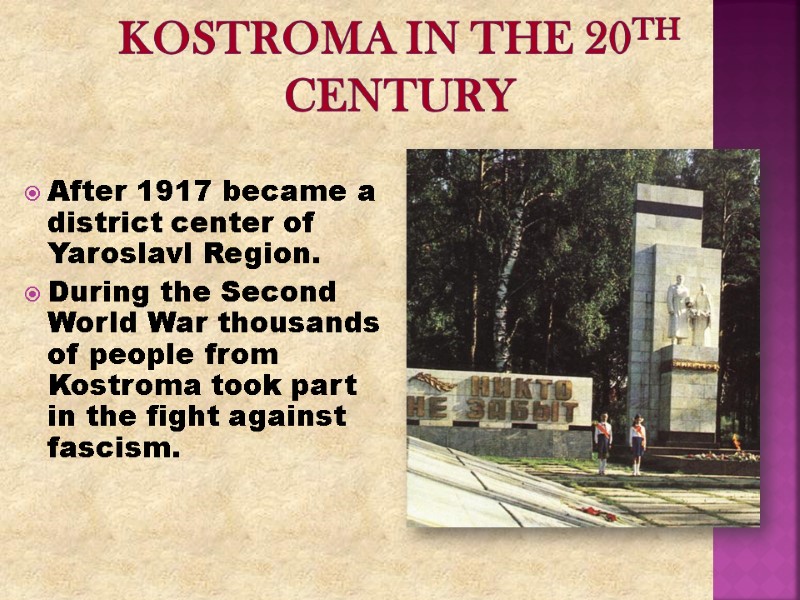
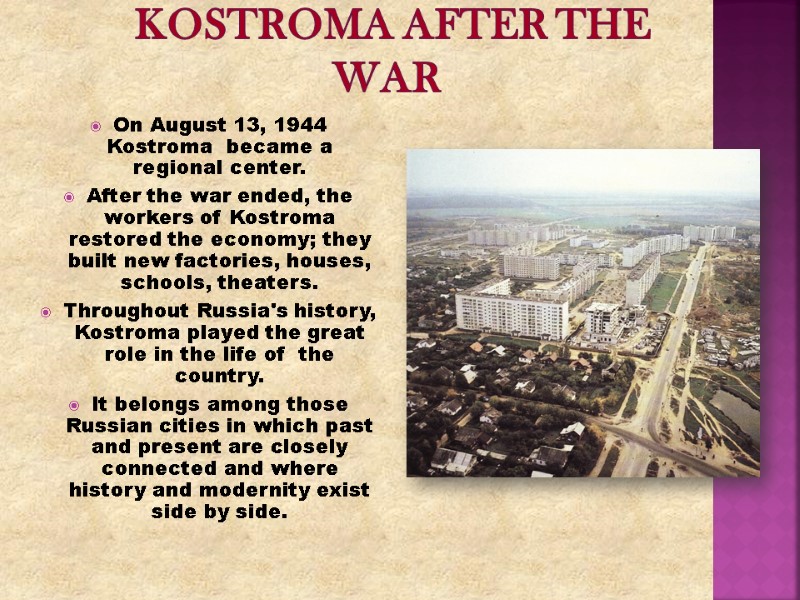
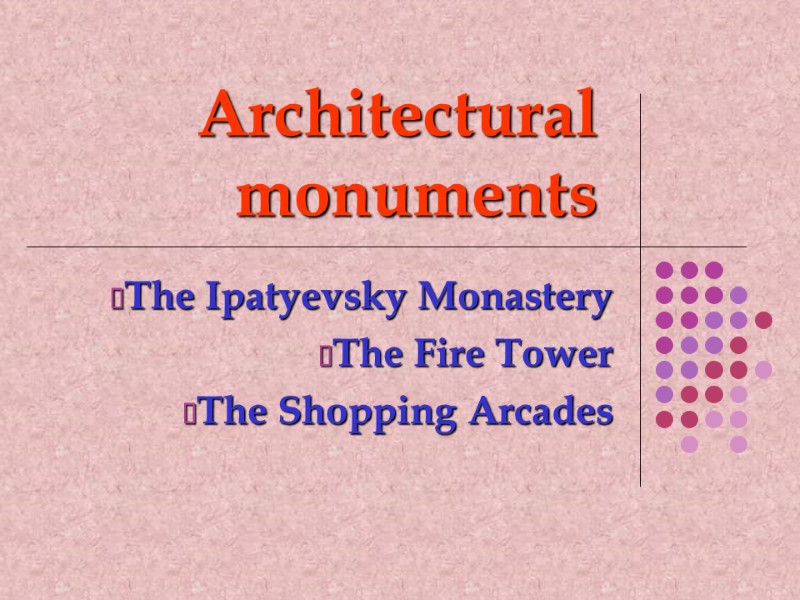
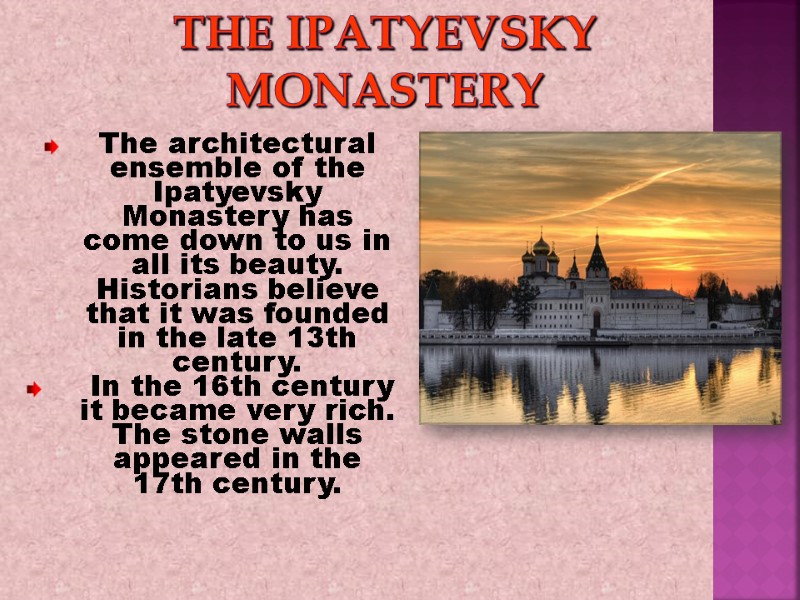
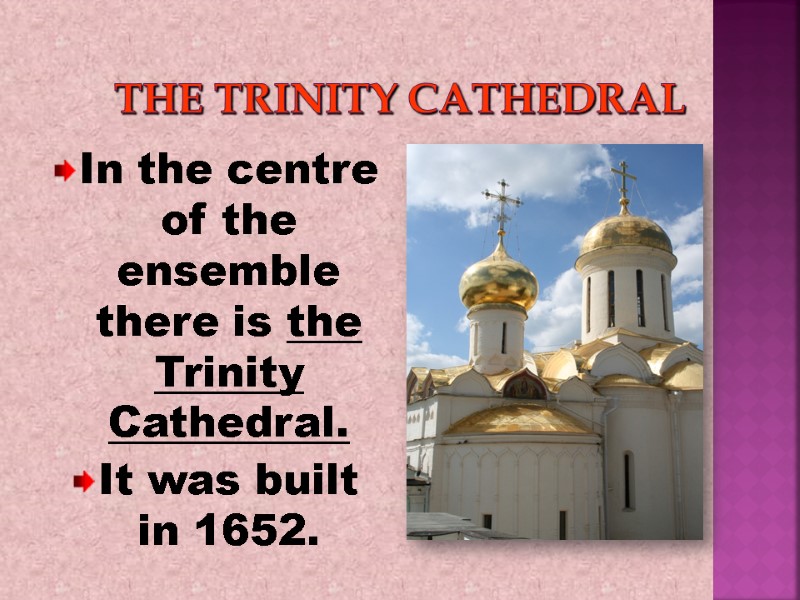
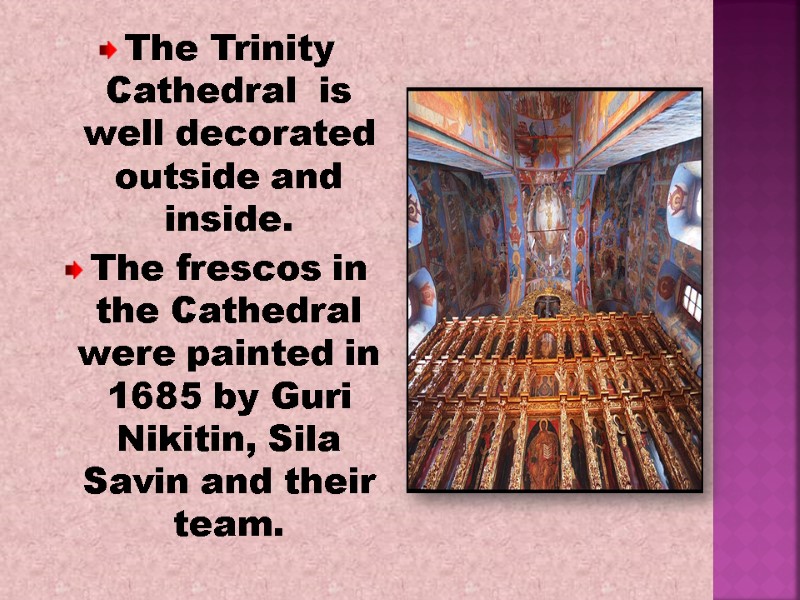
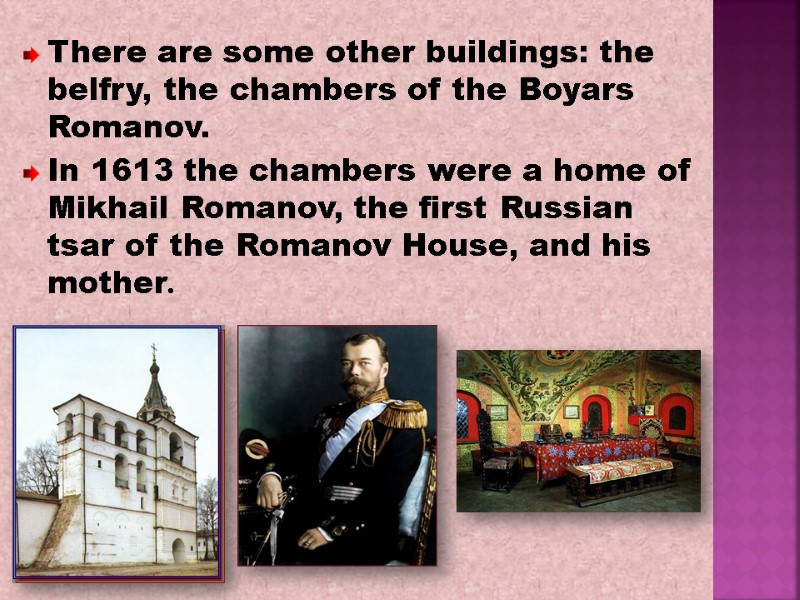
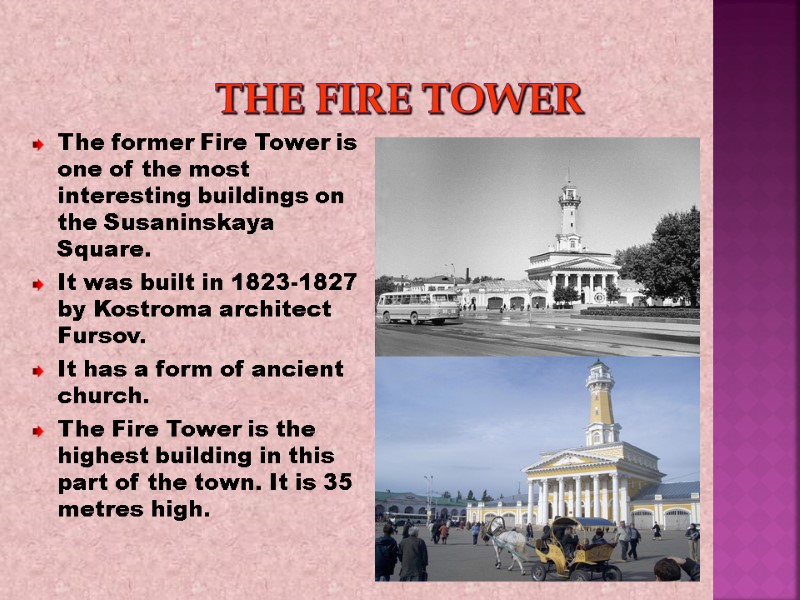
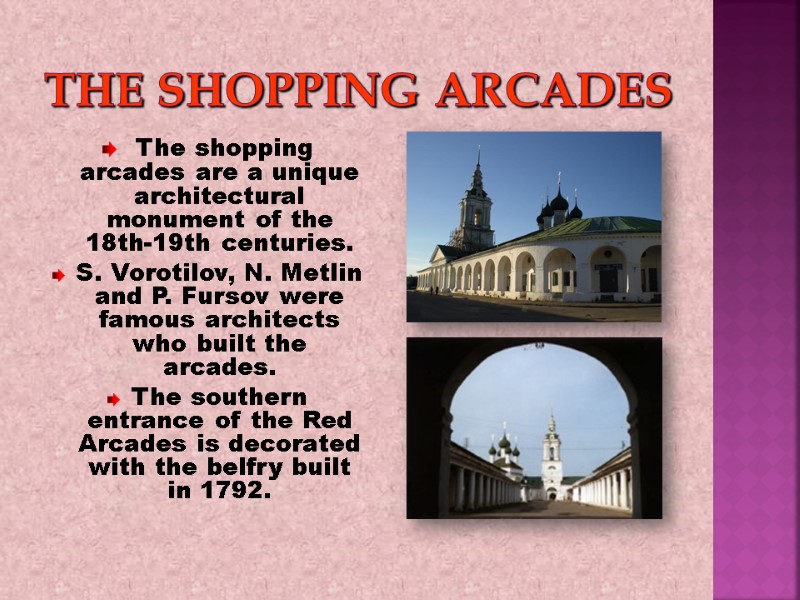
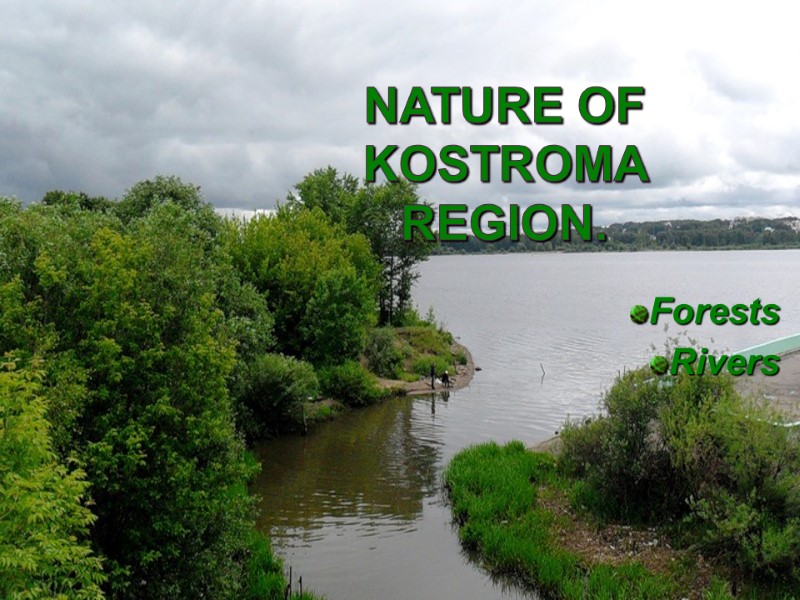
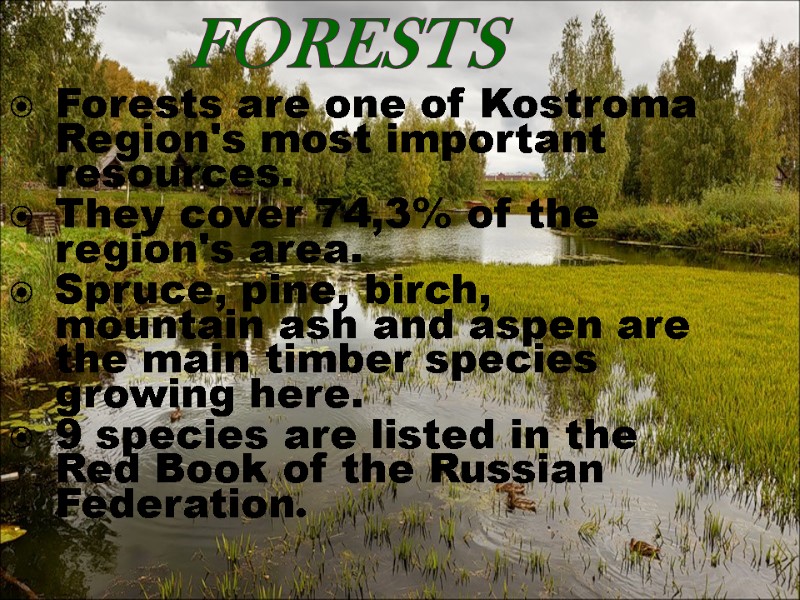
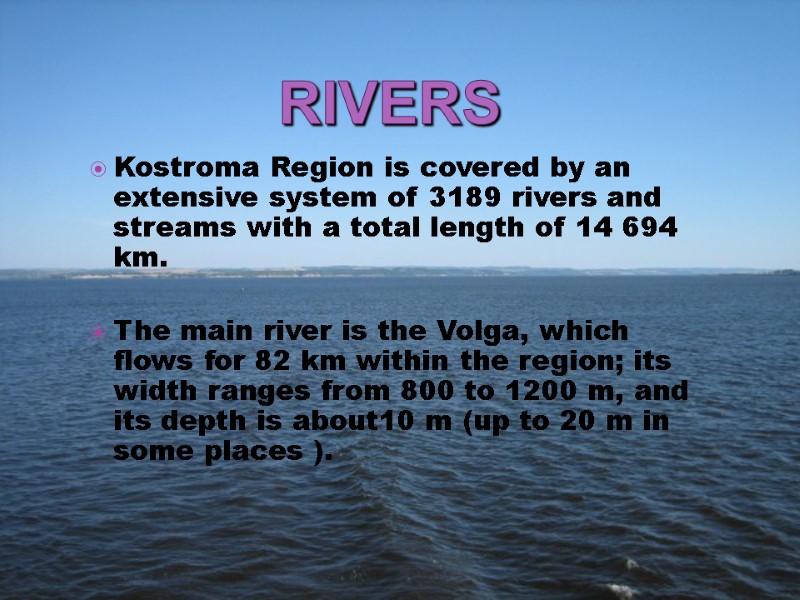
304-kostroma_region_of_russian_federation.ppt
- Количество слайдов: 29
 Kostroma Region of Russian Federation The Town of Kostroma Performed work: Ksenia Lebedeva and Luyba Shalaeva
Kostroma Region of Russian Federation The Town of Kostroma Performed work: Ksenia Lebedeva and Luyba Shalaeva
 Geographical Location Kostroma Region is located in the central part of the East-European Plain. It borders on Ivanovo, Yaroslavl, Vologda, Kirov and Nizhny Novgorod regions. It covers an area of 60 100 sq. km The main river is the Volga and its tributaries are the Kostroma, Unzha and Vetluga rivers. There are many lakes in the region, the largest of which are Galichskoe and Chukhlomskoe.
Geographical Location Kostroma Region is located in the central part of the East-European Plain. It borders on Ivanovo, Yaroslavl, Vologda, Kirov and Nizhny Novgorod regions. It covers an area of 60 100 sq. km The main river is the Volga and its tributaries are the Kostroma, Unzha and Vetluga rivers. There are many lakes in the region, the largest of which are Galichskoe and Chukhlomskoe.
 General Information The region was formed on August 13, 1944. It is divided into 24 administrative districts. The population is 791 400 people. The largest cities are Kostroma, Bui, Nerekhta, Sharya, Manturovo, and Galich.
General Information The region was formed on August 13, 1944. It is divided into 24 administrative districts. The population is 791 400 people. The largest cities are Kostroma, Bui, Nerekhta, Sharya, Manturovo, and Galich.
 Kostroma Kostroma is the regional center and one of Russia's oldest cities. It is the part of the famous "Golden Ring" of Russia. It is located 362 km to the north-east from Moscow. The population of Kostroma is 464 640 people.
Kostroma Kostroma is the regional center and one of Russia's oldest cities. It is the part of the famous "Golden Ring" of Russia. It is located 362 km to the north-east from Moscow. The population of Kostroma is 464 640 people.
 Main Industries Kostroma Region is part of the Central economic district. The main industries are textiles, woodworking, engineering, jewelry and food. There is the State Regional Power Plant (Kostromskaya GRES) in Volgorechensk.
Main Industries Kostroma Region is part of the Central economic district. The main industries are textiles, woodworking, engineering, jewelry and food. There is the State Regional Power Plant (Kostromskaya GRES) in Volgorechensk.
 Education and Medical Care There are 6 higher educational institutions, 19 secondary technical schools and 550 schools in the region. The regional health care system includes 94 hospitals.
Education and Medical Care There are 6 higher educational institutions, 19 secondary technical schools and 550 schools in the region. The regional health care system includes 94 hospitals.
 Cultural Life The city of Kostroma is the center of the region's cultural life. There are theatres, cinemas, museums, art galleries, sports clubs, cafes, entertainment centers and discos in Kostroma.
Cultural Life The city of Kostroma is the center of the region's cultural life. There are theatres, cinemas, museums, art galleries, sports clubs, cafes, entertainment centers and discos in Kostroma.
 Many famous writers, poets, artists and playwrights lived and worked in Kostroma. One of them was the Russian dramatist Aleksander Nikolaevich Ostrovsky. In our town there is a drama theatre named after Ostrovsky. The Ostrovsky museum house is located in the village of Shchelykovo.
Many famous writers, poets, artists and playwrights lived and worked in Kostroma. One of them was the Russian dramatist Aleksander Nikolaevich Ostrovsky. In our town there is a drama theatre named after Ostrovsky. The Ostrovsky museum house is located in the village of Shchelykovo.
 The History of Kostroma 3. Kostroma in the period of the Russian “Trouble” 1. The First Settlers in Kostroma area 2. The foundation of Kostroma 4. Kostroma after the War
The History of Kostroma 3. Kostroma in the period of the Russian “Trouble” 1. The First Settlers in Kostroma area 2. The foundation of Kostroma 4. Kostroma after the War
 The First Settlers in Kostroma area Kostroma is one of Russia's oldest towns. Kostroma played a special and very important role in the formation of the Russian state. In ancient times Meryan tribes lived in the forests of the Middle Volga. In the late 9th century, Slavic colonists from southwestern Rus arrived here. They founded a small settlement at the confluence of the Kostroma and Volga rivers.
The First Settlers in Kostroma area Kostroma is one of Russia's oldest towns. Kostroma played a special and very important role in the formation of the Russian state. In ancient times Meryan tribes lived in the forests of the Middle Volga. In the late 9th century, Slavic colonists from southwestern Rus arrived here. They founded a small settlement at the confluence of the Kostroma and Volga rivers.
 The foundation of Kostroma In 1152, Yuriy Dolgorukiy prince of Rostov and Suzdal, founded the fortress city of Kostroma to defend the northern borders of his domain. Kostroma is first mentioned in the Voskresensk and Tver chronicles around 1213.
The foundation of Kostroma In 1152, Yuriy Dolgorukiy prince of Rostov and Suzdal, founded the fortress city of Kostroma to defend the northern borders of his domain. Kostroma is first mentioned in the Voskresensk and Tver chronicles around 1213.
 The fight of Kostroma people against enemies The city more than once witnessed enemy invasions and internal wars. The people of Kostroma fought against the Golden Horde in the 13th and 14th centuries. Kostroma suffered greatly under the Tatar-Mongol yoke. In 1264, under the leadership of Prince Vasily Yaroslavovich, the people of Kostroma won the first Russian victory over Tatar-Mongol forces on the shores of a lake named Holy (Svyatoe) in honor of this feat.
The fight of Kostroma people against enemies The city more than once witnessed enemy invasions and internal wars. The people of Kostroma fought against the Golden Horde in the 13th and 14th centuries. Kostroma suffered greatly under the Tatar-Mongol yoke. In 1264, under the leadership of Prince Vasily Yaroslavovich, the people of Kostroma won the first Russian victory over Tatar-Mongol forces on the shores of a lake named Holy (Svyatoe) in honor of this feat.
 In 1612 Kostroma played a leading role in the organization of the militia of Kuzma Minin and the prince of Pozharsk during the Polish-Lithuanian intervention.
In 1612 Kostroma played a leading role in the organization of the militia of Kuzma Minin and the prince of Pozharsk during the Polish-Lithuanian intervention.
 Kostroma in the period of “Trouble” Kostroma lands became famous as the birthplace of the new Russian royal dynasty. The founder of it was Mikhail Fedorovich Romanov. He became the tsar of Russia in 1613.
Kostroma in the period of “Trouble” Kostroma lands became famous as the birthplace of the new Russian royal dynasty. The founder of it was Mikhail Fedorovich Romanov. He became the tsar of Russia in 1613.
 Ivan Susanin All Russian people know the name of Ivan Susanin, a Russian peasant who saved Mikhail Romanov from a Polish detachment.
Ivan Susanin All Russian people know the name of Ivan Susanin, a Russian peasant who saved Mikhail Romanov from a Polish detachment.
 A Russian Patriot In 1613 Ivan Susanin helped the future tsar to hide from the enemies. He led the Polish into a forest and they couldn`t find the way back. They killed Susanin but all of them died in deep Kostroma marsh.
A Russian Patriot In 1613 Ivan Susanin helped the future tsar to hide from the enemies. He led the Polish into a forest and they couldn`t find the way back. They killed Susanin but all of them died in deep Kostroma marsh.
 The Economical Centre Kostroma had great economic significance because it is situated on the Volga trade route which connected Western Europe with the wealthy East. Between the 16th and 18th centuries, Kostroma was a great center with well-developed textile and metalworking industries. Roads from the Rostov-Suzdal lands to the cities of the Upper Volga passed through Kostroma.
The Economical Centre Kostroma had great economic significance because it is situated on the Volga trade route which connected Western Europe with the wealthy East. Between the 16th and 18th centuries, Kostroma was a great center with well-developed textile and metalworking industries. Roads from the Rostov-Suzdal lands to the cities of the Upper Volga passed through Kostroma.
 Kostroma in the 20th century After 1917 became a district center of Yaroslavl Region. During the Second World War thousands of people from Kostroma took part in the fight against fascism.
Kostroma in the 20th century After 1917 became a district center of Yaroslavl Region. During the Second World War thousands of people from Kostroma took part in the fight against fascism.
 Kostroma after the War On August 13, 1944 Kostroma became a regional center. After the war ended, the workers of Kostroma restored the economy; they built new factories, houses, schools, theaters. Throughout Russia's history, Kostroma played the great role in the life of the country. It belongs among those Russian cities in which past and present are closely connected and where history and modernity exist side by side.
Kostroma after the War On August 13, 1944 Kostroma became a regional center. After the war ended, the workers of Kostroma restored the economy; they built new factories, houses, schools, theaters. Throughout Russia's history, Kostroma played the great role in the life of the country. It belongs among those Russian cities in which past and present are closely connected and where history and modernity exist side by side.
 Architectural monuments The Ipatyevsky Monastery The Fire Tower The Shopping Arcades
Architectural monuments The Ipatyevsky Monastery The Fire Tower The Shopping Arcades
 The Ipatyevsky Monastery The architectural ensemble of the Ipatyevsky Monastery has come down to us in all its beauty. Historians believe that it was founded in the late 13th century. In the 16th century it became very rich. The stone walls appeared in the 17th century.
The Ipatyevsky Monastery The architectural ensemble of the Ipatyevsky Monastery has come down to us in all its beauty. Historians believe that it was founded in the late 13th century. In the 16th century it became very rich. The stone walls appeared in the 17th century.
 The Trinity Cathedral In the centre of the ensemble there is the Trinity Cathedral. It was built in 1652.
The Trinity Cathedral In the centre of the ensemble there is the Trinity Cathedral. It was built in 1652.
 The Trinity Cathedral is well decorated outside and inside. The frescos in the Cathedral were painted in 1685 by Guri Nikitin, Sila Savin and their team.
The Trinity Cathedral is well decorated outside and inside. The frescos in the Cathedral were painted in 1685 by Guri Nikitin, Sila Savin and their team.
 There are some other buildings: the belfry, the chambers of the Boyars Romanov. In 1613 the chambers were a home of Mikhail Romanov, the first Russian tsar of the Romanov House, and his mother.
There are some other buildings: the belfry, the chambers of the Boyars Romanov. In 1613 the chambers were a home of Mikhail Romanov, the first Russian tsar of the Romanov House, and his mother.
 The Fire Tower The former Fire Tower is one of the most interesting buildings on the Susaninskaya Square. It was built in 1823-1827 by Kostroma architect Fursov. It has a form of ancient church. The Fire Tower is the highest building in this part of the town. It is 35 metres high.
The Fire Tower The former Fire Tower is one of the most interesting buildings on the Susaninskaya Square. It was built in 1823-1827 by Kostroma architect Fursov. It has a form of ancient church. The Fire Tower is the highest building in this part of the town. It is 35 metres high.
 The shopping arcades The shopping arcades are a unique architectural monument of the 18th-19th centuries. S. Vorotilov, N. Metlin and P. Fursov were famous architects who built the arcades. The southern entrance of the Red Arcades is decorated with the belfry built in 1792.
The shopping arcades The shopping arcades are a unique architectural monument of the 18th-19th centuries. S. Vorotilov, N. Metlin and P. Fursov were famous architects who built the arcades. The southern entrance of the Red Arcades is decorated with the belfry built in 1792.
 Nature of Kostroma Region. Forests Rivers
Nature of Kostroma Region. Forests Rivers
 Forests Forests are one of Kostroma Region's most important resources. They cover 74,3% of the region's area. Spruce, pine, birch, mountain ash and aspen are the main timber species growing here. 9 species are listed in the Red Book of the Russian Federation.
Forests Forests are one of Kostroma Region's most important resources. They cover 74,3% of the region's area. Spruce, pine, birch, mountain ash and aspen are the main timber species growing here. 9 species are listed in the Red Book of the Russian Federation.
 Rivers Kostroma Region is covered by an extensive system of 3189 rivers and streams with a total length of 14 694 km. The main river is the Volga, which flows for 82 km within the region; its width ranges from 800 to 1200 m, and its depth is about10 m (up to 20 m in some places ).
Rivers Kostroma Region is covered by an extensive system of 3189 rivers and streams with a total length of 14 694 km. The main river is the Volga, which flows for 82 km within the region; its width ranges from 800 to 1200 m, and its depth is about10 m (up to 20 m in some places ).
